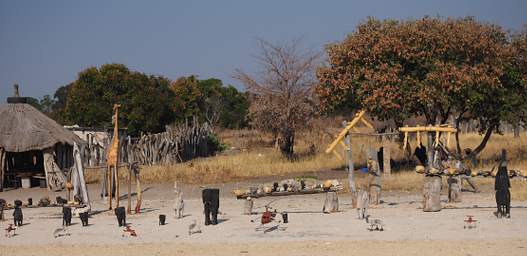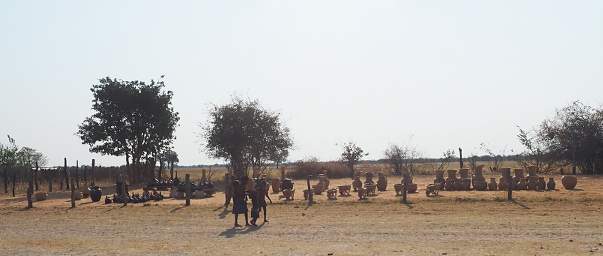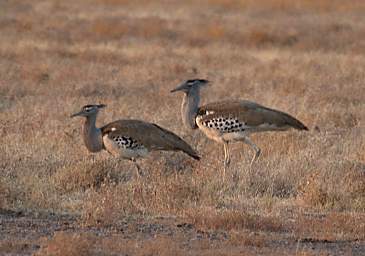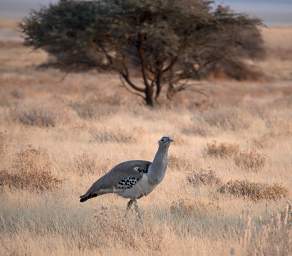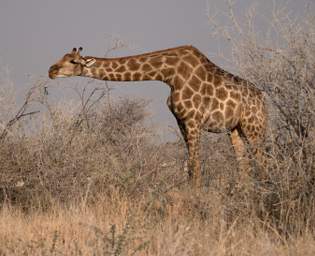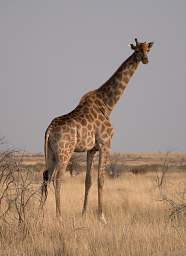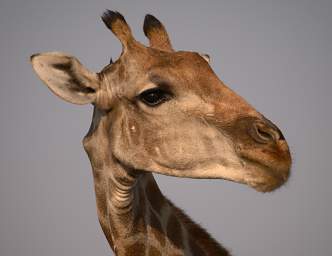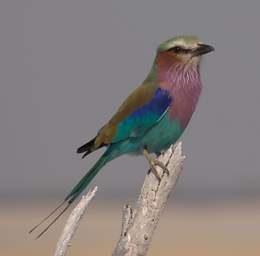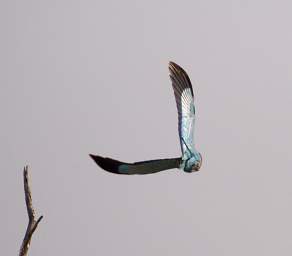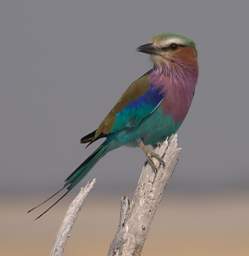Etosha National Park
Too Quick a Visit
August, 2014
Click on any image for a larger view;
Contact garya at this domain if you would like the high quality image for printing
We left Shamvura Camp,
Charlie, and the Okavango River in a good mood;
we'd met some delightful people and found some of the woven baskets
for which Dona had been searching for several months.
We headed for the eastern gate to Etosha National Park,
hoping to camp nearby and spend the next day working our way through the park.
I was particularly keen on seeing the western part of the park,
which had only recently been opened up to general visitors.
We didn't have a whole lot of choices for roads,
but we tried to leave the one major highway and take secondary roads to see more of the country.
We traveled through land occupied by
Damara,
Khoisan and San people,
a mixture of traditional pastoralists and hunter-gatherers turned pastoralists.
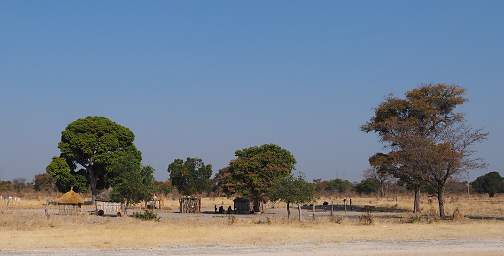 |
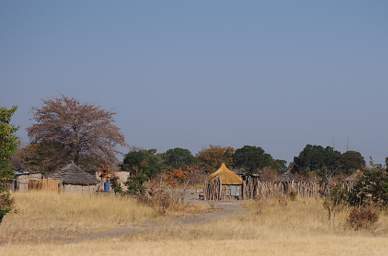 |
| Typical Pastoralist House and Storage Huts |
Every once in a while we would see a youngster with what I would call a "push toy" --
basically a wire-frame toy car which is propelled by pushing it with an attached stiff stick or rod.
I kept thinking we would just happen upon a child with one so we never stopped
and I never got a good close-up picture of one.
They reminded me of the toy hydroplanes we made out of wood and towed behind our bikes when I was a kid.
Most were somewhat more elaborate than the one this boy has,
which appears to be made using soda cans.
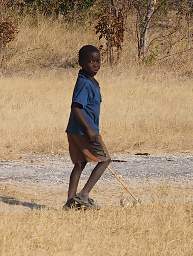 |
| Boy with Push Car |
The dry country between the Okavango and Etosha is poor,
and people line the road with whatever they can think of to sell.
These roadside curio shops are loaded with hand-made stuff limited only by the imagination of the resident.
Model dugout canoes, carved animals, firewood, minerals, baskets, pottery, helicopters...
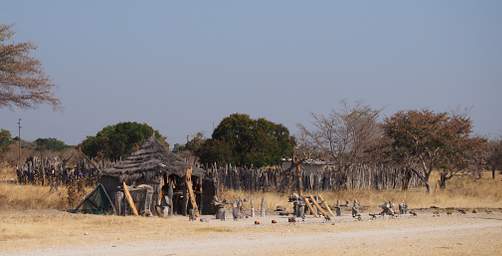 |
| Roadside Curio Shop |
Every family compound had a place to sit under a shade tree,
and it was usually occupied.
It's where people worked if they could,
and where they relaxed and ate.
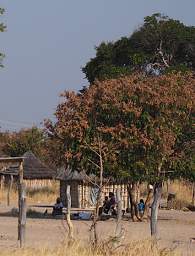 |
| People Under Tree |
Millet is the most important crop in Namibia;
it is the staple food eaten virtually every day at every meal.
We saw millet bundles everywhere.
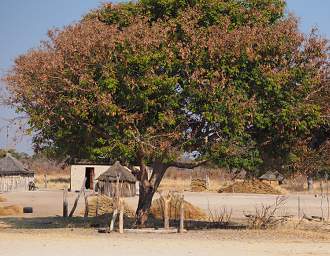 |
| Millet |
Occasionally we would come across a more industrious artisan,
usually someone who made large numbers of items from clay.
They would be displayed along the road,
although sometimes we just saw a big pile of them waiting to be transported to an urban location
for resale.
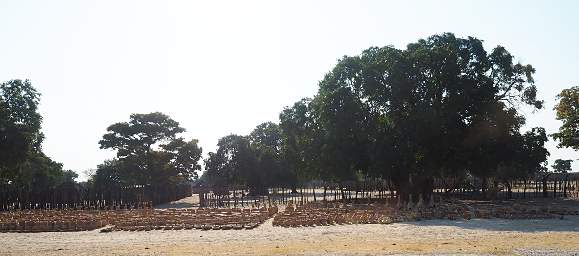 |
| Clay Pots for Sale |
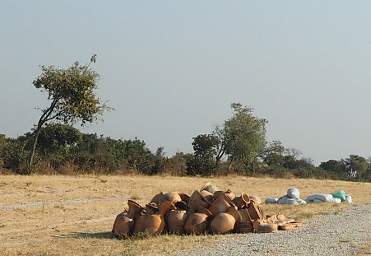 |
| Pot Pile |
Many small villages have no physical infrastructure,
but that doesn't mean they have no local government.
Sometimes we would pass a tree under which everyone had gathered to discuss some important topic.
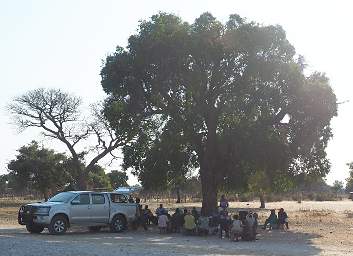 |
| Community Meeting |
As in many places in the United States,
one of the most common businesses in Namibia is the small bar,
sometimes associated with a convenience store,
locally known as a "shebeen".
And just as here, problems associated with excessive alcohol consumption persist.
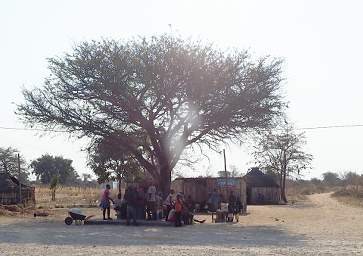 |
| Shebeen |
We were delighted with the roadside tables in Namibia.
There are zillions of them along every road,
spaced at relatively short intervals -- about 25 km.
There was usually only one table under a single tree,
but if you passed one and it was occupied,
chances were pretty good that the next one would not be.
They made stopping for a snack or lunch easy, convenient, and enjoyable.
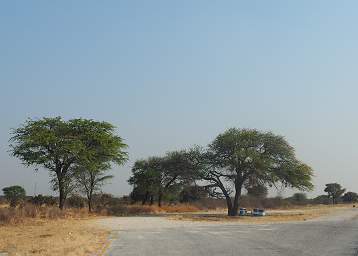 |
| Roadside Table |
Shortly after dark at the end of the day we rolled into a campground
operated and being built by some San people.
The camp, "Treesleeper", was great.
"Elvis", a San man, greeted us and showed us to our camp.
It had an elevated platform for the tent
with a picnic table below;
a barbie, a washbasin,
and a toilet with shower.
It was clean, quiet, and not far from the east entrance to Etosha park.
There were six campsites, and we were the only people there.
A took a look at their guest book was interesting;
most visitors were from northern Europe;
there were few from the United States.
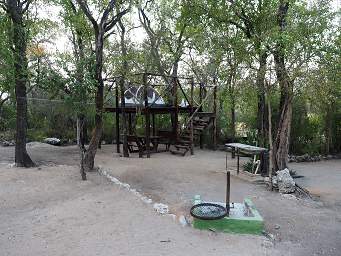 |
| Treesleeper Camp |
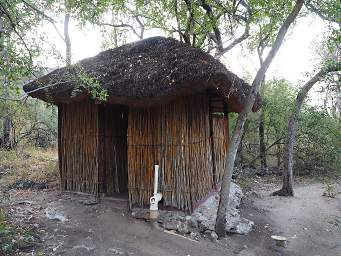 |
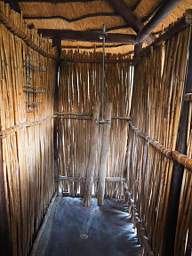 |
| Bathroom |
Shower |
Outside of Etosha, the animals you see are usually domestic -- cows and goats.
As soon as we entered the park, we started seeing wildlife.
The first thing we saw was a nice male
Greater Kudu,
and then some
Kori Bustards,
the largest bird that can fly.
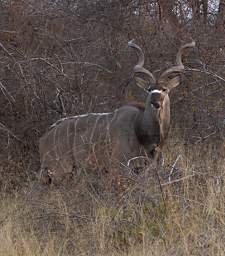 |
| Kudu |
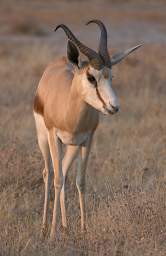 |
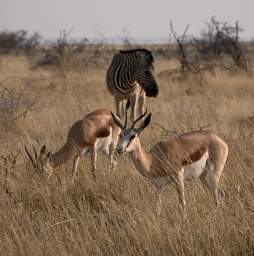 |
| Springbok |
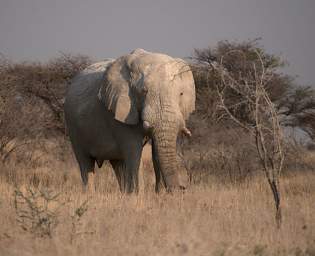 |
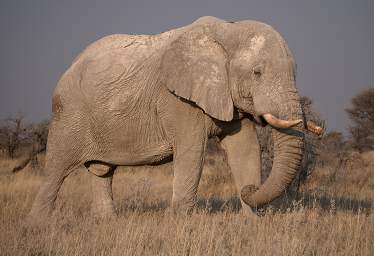 |
| Elephant |
The main feature of Etosha is its huge salt pan.
Most of the time when we saw it there were shimmering mirages which made it look like it actually had water in it;
not at all likely on our visit during the dry season.
We often saw small herds of animals out in the grass near the edge of the pan,
which always surprised me.
I would have thought the forage would have an unpalatable high salt content.
I don't know if the animals are particularly adapted to it,
or if the grasses themselves don't take up that much of it.
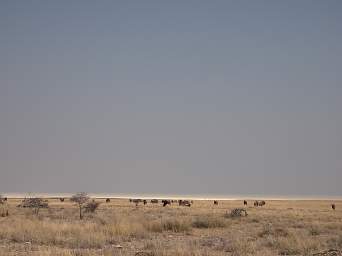 |
| Wildebeests near the Salt Pan |
Another bird we saw was the
Northern Black Korhaan,
which looks similar to a Kori Bustard only smaller.
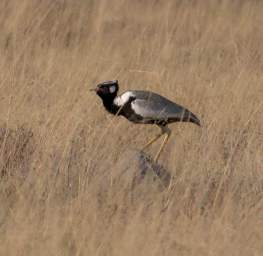 |
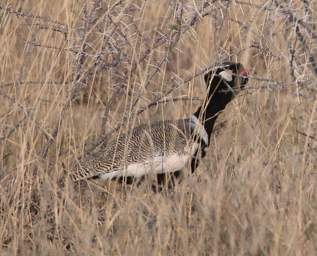 |
| Northern Black Korhaan |
And, of course, Dona's favorite and one of the most colorful birds around...
the Lilac-Breasted Roller.
We never tired of seeing these guys, they are so colorful.
It is the national bird of Botswana and Kenya;
and what a beauty it is!
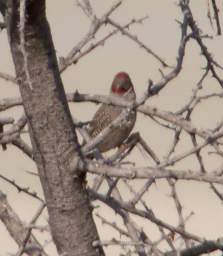 |
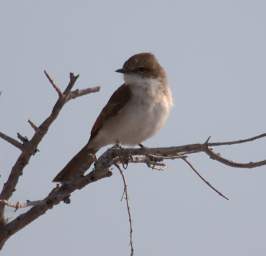 |
| Red Headed Finch |
Bird Xxx |
As we made our was through Etosha,
I made the mistake of looking at the map.
There was a lot of traffic on the main road that runs along the south edge of the salt pan;
I don't like crowds, especially when I'm looking for wildlife.
All of the water holes seemed to have a steady stream of cars going by.
We had done well in Mahango by getting off the beaten path a bit,
so I thought we should head up into the low hills on the south side of the park.
So we turned off when we came to a long loop which went south and then west
and eventually returned to the main road.
At some other time of year, perhaps just after the first rains, it might have been a good idea.
As it was we didn't see much, beat up the car and tires a bit,
and took a lot of time out of the day.
But I guess that's what following your nose is all about.
You win some and you don't win some.
 |
| Springbok |
I would like to return to Etosha sometime not during peak season for ten days or so,
spending time at the east end, Hilali, the central area, and the west end.
We left Etosha and headed into
Damaraland,
on our way to the
Skeleton Coast.






